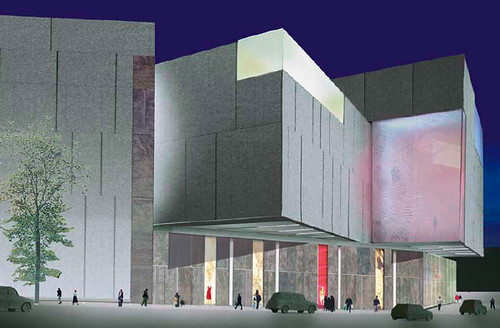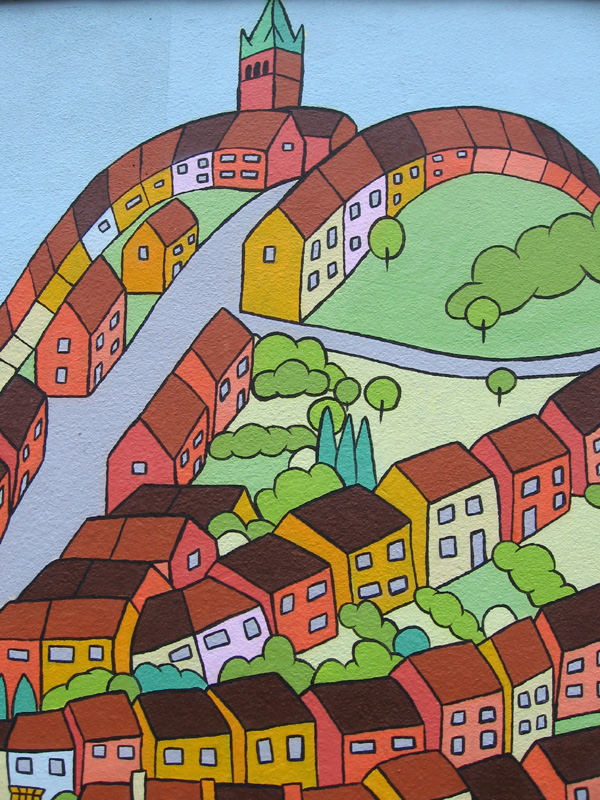
The proposed new flagship House of Fraser store proposed for Broadmead

The National Theatre, South Bank Centre, London

Eugene Street, Kingsdown, Bristol
They (whoever they are) say that Brutalism is making a comeback, which is nice.
Brutalist architecture was popular in the 1960s in Bristol as it combined the fashionable modernist-style liberalism of the elitist social engineers and technocrats of the establishment; the trend for high-handed bureaucratic state planning from the government and civil servants and low-cost solutions to increasing housing, car parking, office space and retail demand.
Much of it is deeply unattractive and hell to live with. In Bristol a lot has already been demolished – Tollgate House, Fairfax House – or is going to be demolished – Nelson Street’s Magistrates Court – or people would like to see it demolished – Eugene Street Car Park (above), the Bristol & West tower. Although some of it has attracted a following – Bristol University Chemistry Department, Bristol UBU Building, The Robinson Building and Clerical Medical on Temple Way.
In general it’s not the fact that the buildings are ugly or even that the housing is tough to live in that turns most people off these buildings. In Bristol Brutalism came as a package alongside daft plans for ‘walkways in the sky‘, major roads through the heart of the city and the demolition of whole neighbourhoods to provide the space for these major roads and the new cut-price, state-planned residential ‘machines for living in’.
The ugly buildings were the end result and the visible expression of a much more complex, alienating and destructive process for many Bristolians.
A whole Brutalist planning regime reigned supreme in the city from the late 50s through to the mid 70s. The result was the destruction of places like Georgian Kingsdown in favour of tower blocks; the working class suburb of Totterdown was demolished to make way for a road that never happened and much of Easton and all of Barton Hill were destroyed by planners and replaced by huge new public housing projects in this modern style.
Whole working class communities were uprooted and swept away in a matter of years. People were effectively cleansed from traditional inner-city neighbourhoods at the Docks, St Judes, Easton, Barton Hill, St Pauls, Redcliffe, Bedminster and Totterdown and sent to distant and isolating satellite estates – Hartcliffe, Withywood, Southmead, Henbury, Lawrence Weston – that were never properly completed and where promised high quality public services never appeared when the cash ran out. You can speak to people in south Bristol who have now been waiting 50 years for the hospital they were promised.
The property left behind in central bristol – much of it of significant historical interest – was either demolished for major roads like the Parkway (M32), Redcliffe Way and Redcliffe Hill, Easton Way and Temple Way; demolished to make way for industrial scale retail and commercial development or demolished for mass housing schemes.
What remained became the cheap inner city property that created the “yuppie” property booms and the inner city gentrification of the 80s, 90s and 00s as the huge value of abandoned inner city working class neighbourhoods and their properties was realised by the speculative middle classes fuelled by their better job security, easy access to credit and mortgage lending and rising living standards.
Brutalism – and the technocratic planning regime of which it was a part – basically created bloody great divisions across large swathes of the city. The intentions may have been honourable but the results were not. It was the architecture and planning for a whole new form of class divide.
By the late 70s, as social mobility began to grind to a halt, the city’s white working classes were largely confined to the fringes of the city with poor quality services in a collapsing industrial climate while the rich and the aspirational were increasingly buying into the centre of the city with its superior services, increasing job prospects and series of property booms. The city you find today and the notorious divisions it contains can be directly traced to this Brutalist period.
Jeremy Isaacs, Chairman of the judging panel for the Capital of Culture award, praised Bristol highly (the city was shortlisted), but felt that the city lost because of these divisions. He felt that the M32, the motorway that enters the city, was ‘a physical manifestation of this rift, creating a concrete divide between the St Paul’s and Easton communities.’
Visiting the city two years after the decision, he said that his views had not changed. ‘The city… has its divisions and it was not absolutely clear that the whole city was joining in and uniting [in the bid]. People came pouring into the middle of the city to get together but it did not mean the other parts of the city got the attention.’
For these reasons that period – its orthodoxies, its planning and its architecture – is viewed by many, many people right across the city with cynicism, considerable dislike and often outright hatred.
So it is strange that the fashionable London-based architectural practice, Stanton Williams, employed by Broadmead Developers, the London-based Bristol Alliance, to design a new “flagship”, “iconic” building for us in Bristol as the centerpiece of the new Broadmead development should come up with something that looks like it comes straight out of the Brutalist handbook.
Did these architects even bother to find out anything about Bristol and its recent past in the course of their work? Did they speak to anyone from Bristol? Consult anyone? Do some basic research? Certainly doesn’t look like it as they’ve gone for a look and feel straight out of one of the most controversial periods in Bristol’s history. But then Stanton Williams concerns aren’t local; they’re working to a global agenda.
Of course, they don’t label this stuff Brutalism any more. Instead Stanton and Williams have some original-sounding waffle to make the cosmetic differences now possible as a result of technological innovation in engineering appear as something entirely new.
They tell us: “The massing of the building along Bond Street … [is] be[ing] developed conceptually as a series of shifting tectonic blocks or plates with geological faults between them.”
And to make you think they’re innovating – or “challenging assumptions” in the lingo – they say: “the original masterplan … was conceived as a curved shaped building, but Stanton Williams challenged this assumption and devised a multi-faceted building instead, forming a strong urban edge along Bond Street.”
What the difference is between a “strong urban edge” with “shifting tectonic blocks” created in steel and concrete and old-fashioned Brutalism is not all that clear. Although this style and language of geometrics spouted by Stanton and Williams is traceable not to Bristol but to Los Angeles and its celebrity architect, “Gruesome” Frank Gehry the Deconstructivist Wunderkid.
Gehry is one of the heroes of this era of globalised corporate capital. He made his name and his money building brutalist fortresses for the global super rich of corporate Los Angeles, expressly designed to keep the new, burgeoning global super poor of blacks, immigrants and the disenfranchised working classes out.
The fact that this style of building and these ideas are now emerging locally is the latest sign of the arrival of this new era of globalised corporate capital here in Bristol. Have no doubt that accompanying Stanton and Williams’ brutalist fortress for the rich will be a panoply of other forces arrayed to keep the poor out of the new Broadmead.
From CCTV to the banning of street drinking. From expensive transport links to expensive luxury goods. From a uniformed security presence to petty rules for petty behaviour. The message to our own emerging super-poor will be only too clear.
Already as part of this new Broadmead ethic, the cleansing of St Pauls is well underway. Again the poorest and the most vulnerable are on the move to make way for the salaried, the young and the urban. It’s hardly a secret that social housing is hard to come by for Afro-Caribbeans in St Pauls now. And this is just the beginning. Already plans are afoot for some more brutalism in the area.
What sets the New Brutalism apart from the old is its fundamental aims. Where the original Brutalism was a failed egalitarian social engineering project driven by a well-intentioned, if naive, state trying to make lives better, the New Brutalism has a very different set of ideals.
New Brutalism also comes as a package with a wider social significance. It is the product and expression of corporate global capital. This is the architecture and planning of the emerging turbo-charged global markets, where heavily rigged competition creates a cut throat world of winners and losers. Where Brutalism at least tried to build homes for people to live in, New Brutalism build homes for the rich to invest in.
This could create divisions in the city way beyond anything the relatively innocent do-gooding looney post war planners with their utopian screw ups managed. It’s unfettered private corporate capital doing the planning now not a social democratic state. As a housing crisis unfolds before our eyes, the only properties being built by the New Brutalist planners are investment apartments, penthouses, lofts and duplexes for the wealthy. Welcome to Bristol, the latest global city of the haves, the have yachts and the have nots.
Stanton and Williams brutalist fortress is only the start, along with Temple Quay and Canons Marsh. A major road, again carving up communities, is being planned to the south of the city along with a bigger, better airport to help transport the global winners. South Bristol is also seeing the first signs of the ubiquitous – in the centre of the city – investment property boom. These changes could radically alter the whole makeup of the south of the city. How long now before Bristol follows the Los Angeles blueprint even further and begins to gate in its rich communities and attempt to design the poor out of every available public space? (Ashton Court festival anyone?)
Not long because the signs are all already there to see.
If Brutalism, first time around, was the architecture of class division then the New Brutalism goes further. It is the architecture and language of open class warfare and Stanton and Williams have just fired the latest salvo.
Photographs and links courtesy of: Groovebox, Joe Dunckley, Vantan, Stringberd, Knautia, Canis Major. Special thanks to Fray Bentos whose photos and commentaries of Bristol over the last 50 years are invaluable.












